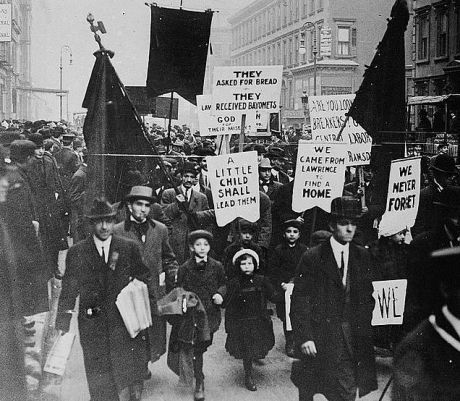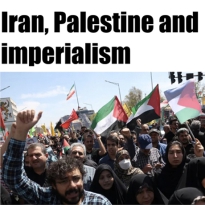Shared
You are here
Bread and Roses: the story of the Lawrence Textile strike

July 20, 2013
100 years ago, in one of the most famous strikes in US history, women and migrant workers in Lawrence challenged oppression and proved their ability to organise and fight.
In 1912 US workers at the Lawrence textile mill struck against reduced pay and poor living conditions. Led mainly by women and migrant workers, the ten week strike demonstrated the potential for uniting male, female and migrant workers in a common fight at the point of production.
Work and living conditions in Lawrence were grim. The average wage of just $9 a week was simply not enough to cover housing, food, medical expenses, and savings for a rainy day. Many workers were forced into overcrowded shared accommodation. In one case 17 people occupied a five bedroom apartment. As one worker described, “When we eat meat it seems like a holiday, especially for the children”.
Mill workers worked long hours, in cramped, damp and humid mills. The risk of injury, tuberculosis and pneumonia was high. Elizabeth Shapleigh, a local doctor, wrote, “A considerable number of the boys and girls die within the first two or three years after beginning work—36 out of every 100 of all the men and women who work in the mill die before or by the time they are 25 years old.”
At the same time, Lawrence produced 25 per cent of all woolen cloth in the US. William Wood, who owned half the mills in Lawrence, became a multi-millionaire off the backs of mill workers.
The strike breaks out
Effective on 1 January 1912, a Massachusetts state law reduced the maximum hours of work each week for women and children. This was an acknowledgement of the long hours they were forced to endure. But in response the American Woolen Company refused to increase the wage rate in order to maintain workers’ take home pay. At the same time it increased the intensity of production in order to maintain output.
When Polish women weavers found their pay had been cut they stopped work, and marched out of the Everett Cotton mill chanting: “short pay, short pay!”. Their loss of pay was significant, amounting to several loaves of bread a week. Workers from other mills joined in and by the week’s end 25,000 workers were on strike.
They included 28 different nationalities, such as Lithuanians, Poles, Russians and Italians, and spoke 45 different languages. They were largely non-unionised and half were young women between the ages of 14 and 18.
The Industrial Workers of the World (IWW) had built a base of 1000 members in the mills before the strike, and quickly sent their best organisers to help. These included Elizabeth Gurley Flynn, a leading female member of the IWW and Bill Haywood, who was greeted by 15,000 workers on his arrival. Unlike other unions at the time, the IWW, made up of anarchists, socialists and other radicals, was willing to organise migrants, women and all workers in united class organisation.
They ensured the strike was democratically organised around mass meetings where tactics were regularly discussed. In between these meetings, a strike committee, consisting of four representatives from each ethnic group, was elected to make major decisions.
Its meetings were translated into 25 different languages. A committee, composed of nine workers from the Lawrence Mills, only one of whom was US born, and IWW organiser Joseph Ettor, negotiated with the textile corporations.
The logistical challenges that emerged were immense. There were 85,000 people either on strike or dependent on strikers. The strike relied on community support to sustain itself. Multi-ethnic community groups emerged to run soup kitchens, and share coal to keep fires burning in winter. A Franco-Belgian soup kitchen fed over 23,000 people during the strike, even though the Franco-Belgian population was only 1200. The Franco-Belgians also offered their 500-seat auditorium as a strike headquarters.
To keep morale up, songs were sung in different languages during marches—so much so that the strike became known as “the singing strike”. This included singing the Internationale, and singing at night to keep known scab workers awake.
Across America supporters held meetings and rallies to raise awareness of the strike. Resolutions were passed in support, and money raised for the strikers. In New York City events were held almost every day during the strike.
State repression
The strike faced considerable state repression. On 19 February 200 police with clubs broke up a picket of 100 women. A Boston paper described the scene: “A woman would be seen to shout from the crowd and run into a side street. Instantly two or three police would be after her. Usually a night-stick well aimed brought the woman to the ground like a shot and instantly the police would be on her”.
A week into the strike a local undertaker planted explosives around the town and attempted to frame the strike leaders for it. He was arrested and later charged over the incident, but only after the arrest of several strike leaders. It was later discovered the undertaker had been paid by the owner of the American Woolen Company, William Wood. Despite this Wood was not charged.
On 29 January, a scuffle between strikers and police led to a bystander, Anna LoPizzo, being shot in the chest and killed. It is likely she was shot by police, as the bullet that hit her came from a police gun. Despite this, strike leaders Joseph Ettor, Arturo Giovannitti, and Joseph Caruso were arrested and charged over the incident. At the time Ettor and Giovannitti were five kilometres away at a workers meeting, and Caruso was at home eating dinner. All three were held in jail for the rest of the strike.
Following this, Governor Foss, who just happened to be a mill owner, called in an additional 12 companies of infantry and two troops of cavalry. Parades, open air meetings, and gatherings of three people or more were banned. A second death occurred when troops armed with bayonets charged a rally as it started to assemble.
Banned from amassing outside individual mills, workers were increasingly creative. They organised moving pickets that continually marched around the mill district. These regularly attracted 3000-6000 people, who would block and shame scabs entering any of the mills.
In an effort to relieve the burden on families, the strike committee organised to send children to live with supporters across the US, where they could be properly fed and clothed for the duration of the strike. The strike gained national attention as the scandalous health conditions of children were publicised. A thousand strong crowd met children arriving at Grand Central Station, New York, and led a parade through the city.
In an attempt to disrupt the tactic, militia and police tried to prevent children boarding trains to Philadelphia. Women and children were injured and arrested—generating further sympathy for the striking workers and their families.
Victory
After ten weeks the American Woolen Company gave in to the strikers’ demands. Wages were increased by between 5 and 25 per cent, paid overtime work increased by 25 per cent, and workers were guaranteed they would not face discrimination for taking part in the strike. Furthermore many other textile companies and manufacturers across the US introduced reforms to avoid any similar strike wave. The Detroit News estimated that 438,000 textile workers received $15 million in raises in the aftermath of the strike.
The victory demonstrated the ability of women and migrant workers to fight for their rights and as political leaders. The momentum of the strike continued into the defence campaign for Joseph Ettor, Arturo Giovannitti, and Joseph Caruso. Fifteen thousand workers struck for one day to demand their release. The IWW threatened a general strike, with Bill Haywood famously demanding, “open the Jails gates or we will close the mill gates”. At one point the defence team was even arrested in an attempt to intimidate them. But the campaign proved successful, and the three were acquitted of murder on 26 November 1912.
Lessons
The strike was not simply about economic concerns but also broader issues. The main slogan adopted was: “We want bread, and roses too!”, with roses symbolising dignity. Women and migrant workers demanded respect as well as decent pay.
At the time women were still not allowed to vote in Massachusetts, and the main union federation at the time, the American Federation of Labour (AFL), disgracefully refused to support the strike. The AFL adopted the sexist attitudes of the time viewing women and migrant workers in the mills as passive victims that could not be organised. Yet women in Lawrence took up leading roles in the struggle and made up half the workers on strike.
The strike saw migrant, women and male workers unite in one of the most militant and successful strikes in US history. The IWW was instrumental in organising the strike because it understood that the fight against sexism and racism was inextricably linked to fighting class exploitation. For women workers, the struggle for better work conditions, wages and housing, then as now, were key to the fight for women’s liberation. In this struggle it was mainly socialists and the working class movement that were their primary allies. Rather than all women having a universal common interest, this showed that they were divided by class.
In the process of struggle divisions between races and genders were broken down, and women used their power as workers to win change for themselves and others.
The strike showed the power of united working class movements to challenge oppression and give women and migrants confidence to organise and fight.
Originally published in Solidarity (Australia). If you live in Canada and agree with these ideas, join the International Socialists
Section:










